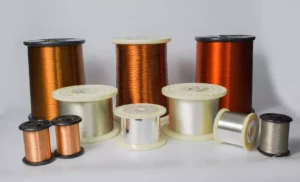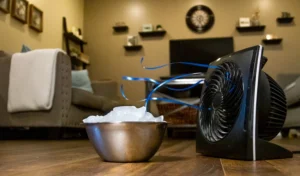Is your kitchen filled with smoke every time you cook?
Grease and strong smells are sticking to your cabinets.
You need a ventilation solution that actually works.
The main difference is filtration and power.
A kitchen chimney is mounted above the stove.
It uses powerful fans and filters to trap grease, smoke, and odors.
An exhaust fan is simpler.
It is often on a wall or window and just moves air out.
Choosing the right one is a big decision for your kitchen.
It affects your air quality, cleaning, and cooking experience.
Let’s look at the details to help you decide.
Understanding the Functionality and Purpose
Smoke and fumes fill the air when you sear a steak.
This makes your kitchen uncomfortable and dirty.
You need to remove these unwanted particles effectively.
A kitchen chimney actively filters the air.
It sucks up smoke, grease, and smells right at the source.
Filters trap the grease and odorous particles.
An exhaust fan just circulates air.
It pulls air from the kitchen and pushes it outside, but it has no filters.
Let’s break this down further.
Both a chimney and an exhaust fan want to clear your kitchen air.
But they do the job in very different ways.
How a Kitchen Chimney Works
A kitchen chimney is a powerful appliance.
You install it right above your cooking stove or cooktop.
Its main job is to catch everything that rises from your cooking.
This includes smoke, steam, grease, and strong cooking smells.
It uses strong fans to create a directional airflow.
This airflow pulls the dirty air up before it can spread.
Inside the chimney, there are special filters.
These filters are the most important part.
They trap the tiny particles of grease.
This stops the grease from settling on your cabinets, walls, and ceiling.
Some filters also help to remove odors.
This process ensures the air is much cleaner.
It makes your kitchen a more pleasant and healthy place to be.
How an Exhaust Fan Works
An exhaust fan is a much simpler machine.
It is usually a basic fan in a housing.
You install it on an outer wall or sometimes in a window.
It does not have any filters to trap grease or odors.
Its only job is to move air from one place to another.
When you turn it on, it pulls the air from inside your kitchen.
Then, it pushes that air directly outside.
This is called simple air circulation.
It can help remove smoke and steam.
It is also good for removing moisture.
But it is not very good at dealing with grease.
The grease particles will just be blown outside or get stuck on the fan blades.
It also doesn’t stop odors as effectively as a chimney.
Kitchen Chimneys: Pros and Cons
You want a modern kitchen that stays clean.
But heavy cooking leaves grease and smoke everywhere.
A good ventilation system is essential, not just a luxury.
The main pros are powerful smoke and grease removal.
Advanced filters clean the air very well.
This leads to better indoor air quality.
The cons are higher cost, more complex installation, and the need for regular filter cleaning.
They also take up more space.
A kitchen chimney has become a must-have for many modern homes.
Let’s look at the specific advantages and disadvantages.
The Good Things (Pros)
- Excellent Removal: They are very effective at removing smoke, steam, and airborne particles right as they are made.
- Better Air Quality: By using advanced filters, chimneys trap grease and eliminate unpleasant cooking odors. This makes the air in your home healthier to breathe.
- Less Cleaning: The filters capture grease particles. This means less sticky grease buildup on your kitchen surfaces. You won’t have to clean your cabinets and walls as often.
- Good Lighting: Many chimney models come with built-in LED lights. These lights shine directly on your cooking area. This gives you better visibility while you cook.
- Modern Look: Chimneys come in many styles and designs. You can find one that matches your kitchen’s aesthetic, from stainless steel to glass.
The Not-So-Good Things (Cons)
- Higher Cost: Chimneys are more expensive than exhaust fans. The appliance itself costs more, and the installation can also be pricey.
- Space Needed: A chimney needs a good amount of space above your cooktop. This can be a problem in very small kitchens or kitchens with low ceilings.
- Regular Maintenance: This is a big one. The filters in the chimney do all the hard work. They get dirty and full of grease. You must clean these filters regularly. Some need to be washed by hand or in a dishwasher. If you don’t clean them, the chimney stops working well.
- Complex Installation: Installing a chimney is more complex than an exhaust fan. It often requires professional help. You may need to install ductwork to vent the air outside.
Exhaust Fans: Pros and Cons
You have a small kitchen or have a tight budget.
You still need ventilation but can’t install a big chimney.
A simpler solution might be all you need.
The main pros are low cost and simple installation.
They are a budget-friendly choice.
They are also good for small kitchens with light cooking.
The cons are low efficiency for grease and odors.
They can be noisy and don’t look very stylish.
Exhaust fans are the traditional choice for kitchen ventilation.
They are simple, but they have their own set of good and bad points.
The Good Things (Pros)
- Low Cost: This is their biggest advantage. Exhaust fans are very affordable. They provide a basic way to ventilate without a big investment.
- Simple Installation: They are much easier to install than a chimney. Many models can be fitted into an existing opening in a wall or window.
- Space Saving: Exhaust fans are small. They don’t take up valuable cabinet or wall space inside the main kitchen area. This makes them great for small kitchens where every inch matters.
- Good for Light Cooking: If you don’t cook often, or if you mostly steam or boil, an exhaust fan might be enough. It can handle small amounts of smoke and moisture well.
The Not-So-Good Things (Cons)
- Less Efficient: They are not very good at removing grease and strong odors. They just move the air. They don’t filter it.
- Grease Buildup: Because they don’t capture grease, the grease particles can build up. They build up on the fan blades, in the duct, and on your kitchen surfaces. This means you have to do more cleaning.
- Noisy Operation: Many exhaust fans can be quite loud. This noise can be annoying when you are cooking or trying to talk in the kitchen.
- Basic Look: Exhaust fans are functional, not stylish. They don’t add much to your kitchen’s design. They are often plain and designed to be hidden.
- Not for Heavy Cooking: If you do a lot of frying or heavy cooking, an exhaust fan will not be enough. It just can’t handle large amounts of smoke and grease.
Maintenance and Cleaning: Chimney vs Exhaust Fan
Your new kitchen fan works great at first.
But now it seems weak and smells bad.
Proper maintenance is the only way to keep it working well.
Chimneys need regular, careful filter cleaning.
You must wash the grease filters often, by hand or in a dishwasher.
Exhaust fans need less filter care (they have none), but the blades and housing get very greasy.
These parts need frequent, direct cleaning.
Keeping your ventilation system clean is key to its performance and lifespan.
The cleaning process is very different for chimneys and exhaust fans.
Cleaning a Kitchen Chimney
A chimney’s maintenance is all about the filters.
- Filter Cleaning: Most modern chimneys have filters that you can remove. These filters trap all the grease. You need to clean them regularly. Some guides say every few weeks, depending on your cooking. You can often wash them in your dishwasher. Or you can soak them in hot, soapy water and scrub them.
- Charcoal Filters: If your chimney is ductless, it also has charcoal filters. These filters trap odors. You cannot clean them. You must replace them every 3-6 months.
- Wiping Surfaces: You should also wipe down the outside and inside surfaces. A damp cloth can remove any dust or grease that settled.
- Annual Check-up: It’s a good idea to have a professional check the motor and other parts once a year. This ensures everything is working correctly.
Cleaning an Exhaust Fan
An exhaust fan’s maintenance is more about direct scrubbing.
- Cleaning the Blades: The fan blades get covered in grease and dust. You will need to turn off the power. Then, you must remove the cover and clean the blades. This often means soaking them in a soapy solution. You have to scrub them to get the sticky grease off.
- Wiping the Housing: The inside of the fan housing and the motor area also get dirty. You need to wipe these parts down with a damp cloth.
- Lubrication: Some older exhaust fan motors may need occasional oiling to keep running smoothly.
- Frequency: Because it doesn’t have a filter, the fan itself gets dirty faster. You may need to clean it more often, especially if you do a lot of frying.
Noise Levels and Energy Use Compared
You want to cook in peace.
But your ventilation fan is so loud you can’t even hear music.
You also worry about your high electricity bill.
Exhaust fans often run at one noisy, constant speed.
This can use more energy than needed.
Modern chimneys are often quieter, especially at lower speeds.
They have variable speeds and features like timers, which makes them more energy-efficient.
A quiet and efficient kitchen makes cooking more enjoyable.
Let’s see how chimneys and exhaust fans stack up in noise and energy.
Noise Levels
No one likes a loud kitchen.
- Exhaust Fans: Traditional exhaust fans are often noisy. They usually have simple, single-speed motors. When they are on, they are on at full power. This can create a lot of noise from the motor and the air turbulence.
- Kitchen Chimneys: Modern chimneys are generally designed to be quieter. They often have better motors. Most importantly, they have variable speed settings. You can use a high, powerful speed when you are searing. But you can use a much quieter, lower speed for simmering. Some high-end models even have a ‘silent mode’ for very quiet operation.
Energy Efficiency
Your kitchen appliances can add up on your electricity bill.
- Exhaust Fans: These fans often run at a constant speed. This means they use the same amount of energy whether you are boiling water or frying fish. They also have no smart features. If you forget to turn it off, it will keep running and wasting energy.
- Kitchen Chimneys: Chimneys are often more energy-efficient. The variable speed settings let you use only the power you need. Lower speeds use less electricity. Many modern chimneys also have smart features. They may have a timer or a sensor. This can shut the chimney off automatically after a set time. This prevents you from wasting energy. They also have efficient LED lights, which use very little power.
Aesthetics, Design, and Safety
You spent a lot of money on your beautiful kitchen design.
But a clunky, ugly fan can ruin the whole look.
You also worry about the risk of grease fires.
Chimneys are a design feature.
They come in many stylish options like glass or stainless steel.
Exhaust fans are functional and often hidden.
For safety, chimneys are better.
Their filters trap grease, reducing the risk of grease fires.
Your ventilation choice affects how your kitchen looks and how safe it is.
Aesthetics and Kitchen Design
The look of your kitchen matters.
- Exhaust Fans: These fans are built for function, not fashion. Their design is usually basic and plain. They are often made of plastic. Most people try to install them in an unobtrusive place, like a high corner or on a side wall. They do not add to your kitchen’s decor.
- Kitchen Chimneys: Chimneys are designed to be a centerpiece. They are a prominent feature above your stove. Because of this, they come in many beautiful designs. You can get wall-mounted chimneys, island chimneys, or corner chimneys. They are made from materials like stainless steel and tempered glass. They often have sleek lines and add a modern, sophisticated look to the kitchen.
Safety Considerations
Safety is the most important thing in any kitchen.
- Exhaust Fans: The biggest safety risk with exhaust fans is grease buildup. Since there are no filters, grease can collect on the fan blades and in the ductwork. This buildup is highly flammable. If it gets too hot, it can ignite and cause a grease fire. The noise can also be a safety issue, as it might distract you or prevent you from hearing other kitchen alerts.
- Kitchen Chimneys: Chimneys are generally safer. The metal filters are designed to trap grease. This prevents the grease from building up in the ducts. This significantly reduces the risk of a grease fire. Many chimneys also have auto-clean features that help keep the unit in optimal condition.
What About Ductless Chimneys?
You want a chimney, but your kitchen has no outside wall.
Running a new duct seems impossible or too expensive.
You feel stuck with no good options.
A ductless chimney is a great solution for apartments or homes without vents.
It does not vent air outside.
Instead, it pulls air through grease filters and then a charcoal filter to remove odors.
Finally, it recirculates the clean air back into the kitchen.
Not all kitchens can have a duct going outside.
This is common in apartments, condos, or on an interior kitchen wall.
This is where ductless kitchen chimneys come in.
How Ductless Chimneys Work
A ductless chimney looks just like a regular (ducted) chimney.
But it works very differently.
It does not push air outside.
Instead, it purifies the air and sends it back into the room.
The process has two main stages:
- Grease Filters: First, the air is pulled through metal filters. These are just like the filters in a ducted chimney. They trap all the grease and oil particles.
- Charcoal Filters: Next, the air passes through activated carbon filters (or charcoal filters). These filters are very porous. They absorb cooking odors, smoke, and other impurities from the air.
After passing through both filters, the “clean” air is released back into your kitchen.
Ductless Chimney vs. Exhaust Fan
How does a ductless chimney compare to a simple exhaust fan?
- Installation: A ductless chimney is much easier to install than an exhaust fan. An exhaust fan must have a hole in the wall. A ductless chimney can be mounted anywhere.
- Filtration: The ductless chimney is much better at cleaning the air. It traps grease (which an exhaust fan doesn’t) and removes odors (which an exhaust fan is bad at).
- Moisture: This is the one big weakness. A ductless chimney does not remove moisture or steam from your kitchen. It just recirculates it. An exhaust fan does remove moisture by sending it outside.
- Maintenance: A ductless chimney has more maintenance. You must clean the grease filters and you must buy and replace the charcoal filters every 3-6 months.
This option is great for people who cannot install ducts.
It offers the style and grease-trapping benefits of a chimney.
But it is not as good as a fully ducted system for removing all contaminants.
Conclusion
Your choice depends on your cooking habits, kitchen size, and budget.
A chimney is best for heavy cooking, air quality, and design.
An exhaust fan is a simple, budget-friendly choice for light ventilation.
Frequently Asked Questions
Which is better for a small kitchen: chimney or exhaust fan?
An exhaust fan is often better for very small kitchens.
It saves space by fitting in a wall or window.
A chimney needs more space above the stove.
Do kitchen chimneys make noise?
Yes, but modern chimneys are often quieter than exhaust fans.
They have multiple speed settings, and the low settings are very quiet.
Can I install a kitchen chimney myself?
It is complex.
A ductless chimney is easier.
But a ducted chimney usually needs professional installation to cut holes and run ductwork.
How often do I need to clean a chimney filter?
You should clean the grease filters every 2-4 weeks, depending on your cooking.
If it is ductless, you must replace the charcoal filters every 3-6 months.
Is an exhaust fan enough for cooking?
It is enough for light cooking, like boiling or steaming.
It is not enough for heavy frying or spicy cooking that creates a lot of grease and smoke.
Which is more expensive, chimney or exhaust fan?
A kitchen chimney is much more expensive.
This includes both the cost of the unit and the cost of installation.
An exhaust fan is a low-cost option.
Do I need a chimney if I have an open kitchen?
A chimney is highly recommended for an open kitchen.
It stops cooking smells and grease from spreading into your living room and furniture.
What is the difference between ducted and ductless chimney?
A ducted chimney vents air outside.
A ductless chimney filters air (for grease and odors) and recirculates it back into the kitchen.






